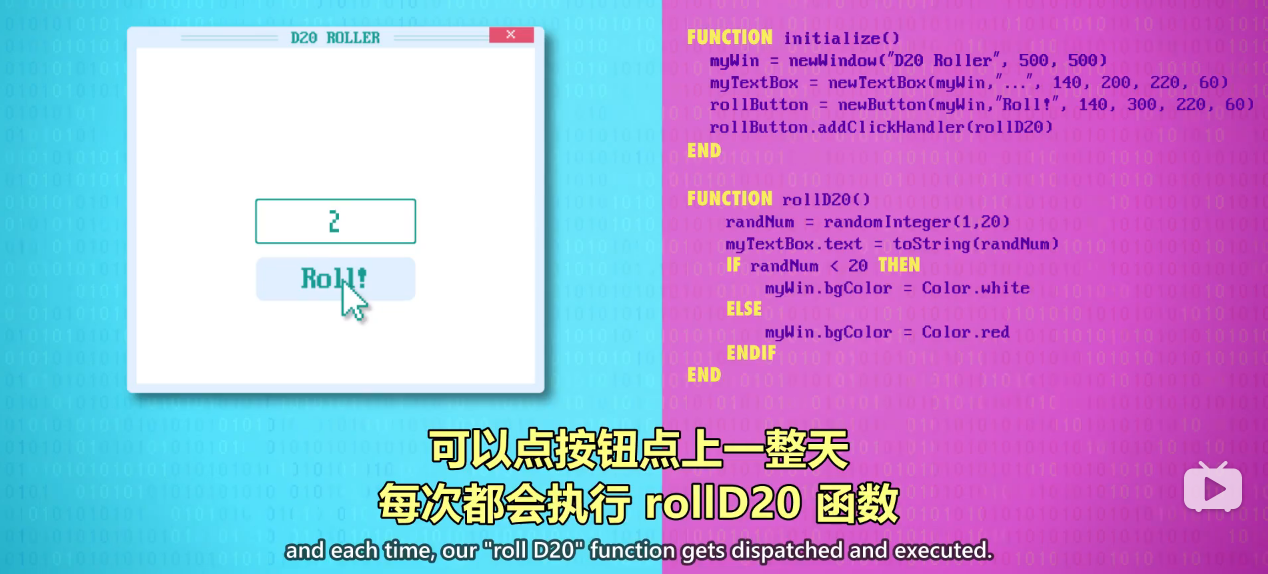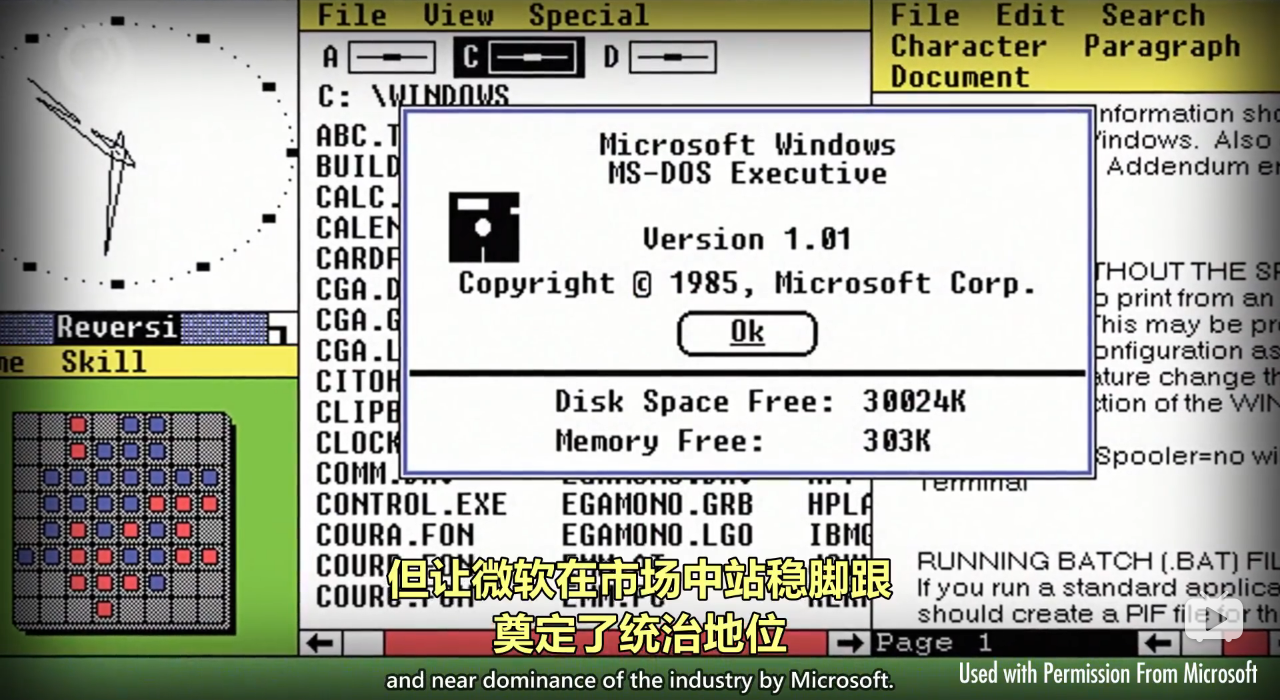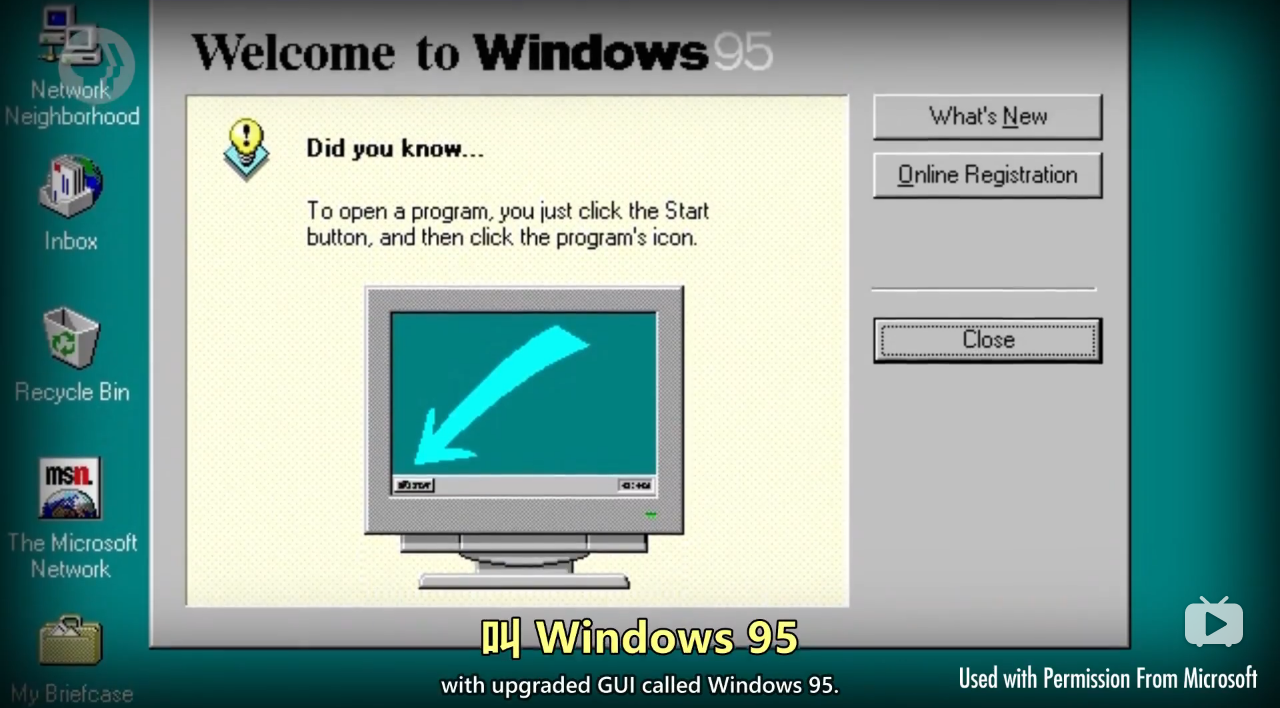26 Graphical User Interfaces
26 图形用户界面
Hi, I'm Carrie Anne, and welcome to CrashCourse Computer Science!
嗨 我是 Carrie Anne 欢迎收看计算机科学速成课
We ended last episode with the 1984 release of Apple's Macintosh personal computer.
我们上集最后,谈了苹果在1984年发布的 Macintosh
It was the first computer a regular person could buy with a graphical user interface
这是普通人可以买到的,第一台带图形用户界面的计算机
and a mouse to interact with it.
还带一个鼠标
This was a radical evolution from the command line interfaces
那时的计算机全是命令行,
found on all other personal computers of the era.
图形界面是个革命性进展
Instead of having to remember...
不必记住
or guess... the right commands to type in,
或猜测正确的命令
a graphical user interface shows you what functions are possible.
图形界面直接显示了,你可以做什么
You just have to look around the screen for what you want to do.
只要在屏幕上找选项就行了
It's a "point and click" interface.
这是一个"选择并点击"的界面
All of a sudden, computers were much more intuitive.
突然间计算机更直观了
Anybody, not just hobbyists or computer scientists,
不只是爱好者或科学家能用计算机,
could figure things out all by themselves.
任何人都可以用计算机解决问题
The Macintosh is credited with taking Graphical User Interfaces, or GUIs, mainstream,
人们认为是 Macintosh,把图形用户界面(GUI)变成主流
but in reality they were the result of many decades of research.
但实际上图形界面是数十年研究的成果
In previous episodes, we discussed some early interactive graphical applications,
前几集,我们讨论了早期的交互式图形程序
like Sketchpad and Spacewar!, both made in 1962.
比如 Sketchpad 和太空战争,都是1962年制作的
But these were one-off programs,
但都是一次性项目,不是整合良好的体验
and not whole integrated computing experiences.
但都是一次性项目,不是整合良好的体验
Arguably, the true forefather of modern GUIs was Douglas Engelbart.
现代图形界面的先驱,可以说是 道格拉斯·恩格尔巴特
Let's go to the thought bubble!
让我们进入思想泡泡!
During World War 2, while Engelbart was stationed in the Philippines as a radar operator,
二战期间,恩格尔巴特 驻扎在菲律宾做雷达操作员
he read Vannevar Bush's article on the Memex.
他读了 万尼瓦尔·布什 的 Memex 文章
These ideas inspired him,
这些文章启发了他
and when his Navy service ended,
当他海军服役结束时
he returned to school, completing a Ph.D. in 1955 at U.C. Berkeley.
他回到学校 ,1955年在 UCB 取得博士学位
Heavily involved in the emerging computing scene,
他沉溺于新兴的计算机领域
he collected his thoughts in a seminal 1962 report,
他在1962年一份开创性报告中,汇集了各种想法
titled: "Augmenting Human Intellect".
报告名为:"增强人类智力"
Engelbart believed that the complexity of the problems facing mankind
恩格尔巴特认为,人类面临的问题,
was growing faster than our ability to solve them.
比解决问题的能力增长得更快
Therefore, finding ways to augment our intellect
因此,找到增强智力的方法,
would seem to be both a necessary and a desirable goal.
似乎是必要且值得一做的目标
He saw that computers could be useful beyond just automation,
他构想计算机不仅做自动化工作
and be essential interactive tools for future knowledge workers to tackle complex problems.
也可以成为未来知识型员工,应对复杂问题的工具
Further inspired by Ivan Sutherland's recently demonstrated Sketchpad,
伊凡·苏泽兰 的"几何画板",进一步启发了 恩格尔巴特
Engelbart set out to make his vision a reality, recruiting a team to build the oN-Line System.
他决定动手把愿景变为现实,开始招募团队来做 oN-Line System
He recognized that a keyboard alone was insufficient
他意识到如果只有键盘,
for the type of applications he was hoping to enable.
对他想搭建的程序来说是不够的
In his words:
用他的话说:
We envisioned problem-solvers using computer-aided working stations to augment their efforts.
我们设想人们用计算机辅助工作站来增强工作
They required the ability to interact with information displays
用户需要和屏幕上的信息互动
using some sort of device to move [a cursor] around the screen."
用某种设备在屏幕上移动[光标]"
And in 1964, working with colleague Bill English,
1964年,和同事比尔·英格利希的共同努力下
he created the very first computer mouse.
他创造了第一个计算机鼠标,
The wire came from the bottom of the device
尾部有一根线
and looked very much like a rodent and the nickname stuck.
看起来很像老鼠,因此"鼠标"这个名字沿用了下来
Thanks thought bubble!
谢了思想泡泡!
In 1968, Engelbart demonstrated his whole system at the Fall Joint Computer Conference,
1968年 恩格尔巴特,在"秋季计算机联合会议"展示了他的系统
in what's often referred to as "the mother of all demos".
这次演示 被视为如今所有演示的祖先
The demo was 90 minutes long and demonstrated many features of modern computing:
演示有90分钟,展现了现代计算机的许多功能:
bitmapped graphics,
包括 位图图像
video conferencing,
视频会议
word processing,
文字处理
and collaborative real-time editing of documents.
和 实时协作编辑文件
There were also precursors to modern GUIs,
还有现代图形界面的原型
like the mouse and multiple windows
比如鼠标和多窗口
although they couldn't overlap.
不过窗口不能重叠
It was way ahead of its time,
远远先于那个时代
and like many products with that label, it ultimately failed,
就像其它"跨时代"的产品一样,它最终失败了
at least commercially.
至少商业上是这样
But its influence on computer researchers of the day was huge.
但它对当时的计算机研究者影响巨大
Engelbart was recognized for this watershed moment in computing with a Turing Award in 1997.
恩格尔巴特 因此获得1997年图灵奖
Federal funding started to reduce in the early 1970s,
政府资金在 1970 年代初开始减少
which we discussed two episodes ago.
我们在两集前说过,(第24集:冷战和消费主义)
At that point, many of Engelbart's team, including Bill English,
那时,恩格尔巴特团队里的许多人,包括比尔·英格利希
left and went to Xerox's newly formed Palo Alto Research Center,
去了施乐公司新成立的"帕洛阿尔托研究中心"
more commonly known as Xerox PARC.
更为人熟知的名字是 Xerox PARC
It was here that the first true GUI computer was developed:
他们在这里开发了第一台带真正 GUI 的计算机:
the Xerox Alto, finished in 1973.
施乐奥托 于1973年完成
For the computer to be easy to use,
为了让计算机易于使用,
it needed more than just fancy graphics.
需要的不只是花哨的图形
It needed to be built around a concept that people were already familiar with,
还要借助一些人们已经熟悉的概念
so they could immediately recognize how to use the interface with little or no training.
让人们不用培训 就能很快明白如何使用
Xerox's answer was to treat the 2D screen like the top of a desk or desktop.
施乐的答案是将2D屏幕当作"桌面"
Just like how you can have many papers laid out on a desk,
就像桌面上放很多文件一样
a user could have several computer programs open at once.
用户可以打开多个程序,
Each was contained in their own frame,
每个程序都在一个框里,
which offered a view onto the application called a window.
叫"窗口"
Also like papers on a desk,
就像桌上的文件一样
these windows could overlap, blocking the items behind them.
窗口可以重叠,挡住后面的东西
And there were desk accessories, like a calculator and clock,
还有桌面配件,比如计算器和时钟
that the user could place on the screen and move around.
用户可以把配件在屏幕上四处移动
It wasn't an exact copy of a desktop though.
它不是现实桌面的完美复制,
Instead, it was a metaphor of a desktop.
而是用桌面这种隐喻
For this reason, surprisingly, it's called the Desktop Metaphor.
因此叫"桌面隐喻"
There are many ways to design an interface like this,
有很多方法来设计界面,
but the Alto team did it with windows, icons, menus, and a pointer
但 Alto 团队用窗口,图标,菜单和指针来做
what's called a WIMP interface.
因此叫 WIMP 界面
It's what most desktop GUIs use today.
如今大部分图形界面都用这个
It also offered a basic set of widgets,
它还提供了一套基本部件
reusable graphical building blocks, things like buttons, checkboxes, sliders, and tabs
可复用的基本元素,比如按钮,打勾框,滑动条和标签页
which were also drawn from real world objects to make them familiar.
这些也来自现实世界,让人们有熟悉感
GUI applications are constructed from these widgets,
GUI 程序就是这些小组件组成的
so let's try coding a simple example using this new programming paradigm.
让我们试着写一个简单例子
First, we have to tell the operating system that we need a new window to be created for our app.
首先,我们必须告诉操作系统,为程序创建一个窗口
We do this through a GUI API.
我们通过 GUI API 实现,需要指定窗口的名字和大小
We need to specify the name of the window and also its size.
我们通过 GUI API 实现,需要指定窗口的名字和大小
Let's say 500 by 500 pixels.
假设是 500×500 像素
Now, let's add some widgets a text box and a button.
现在再加一些小组件,一个文本框和一个按钮
These require a few parameters to create.
创建它们需要一些参数
First, we need to specify what window they should appear in,
首先要指定出现在哪个窗口,
because apps can have multiple windows.
因为程序可以有多个窗口
We also need to specify the default text, the X and Y location in the window, and a width and height.
还要指定默认文字,窗口中的 X,Y 位置 以及宽度和高度
Ok, so now we've got something that looks like a GUI app,
好,现在我们有个,看起来像 GUI 程序的东西
but has no functionality.
但它还没有功能
If you click the "roll" button, nothing happens.
如果点 Roll 按钮,什么也不会发生
In previous examples we've discussed,
在之前的例子中,代码是从上到下执行的
the code pretty much executes from top to bottom.
在之前的例子中,代码是从上到下执行的
GUIs, on the other hand, use what's called event-driven programming;
但 GUI 是 "事件驱动编程"
code can fire at any time, and in different orders, in response to events.
代码可以在任意时间执行 以响应事件
In this case, it's user driven events,
这里是用户触发事件,
like clicking on a button, selecting a menu item, or scrolling a window.
比如点击按钮,选一个菜单项,或滚动窗口
Or if a cat runs across your keyboard,
或一只猫踩过键盘
it's a bunch of events all at once!
就会一次触发好多事件!
Let's say that when the user clicks the "roll" button,
假设当用户点 Roll 按钮
we want to randomly generate a number between 1 and 20,
我们产生1到20之间的随机数
and then show that value in our text box.
然后在文本框中,显示这个数字
We can write a function that does just that.
我们可以写一个函数来做
We can even get a little fancy and say if we get the number 20,
我们还可以让它变有趣些,假设随机数是 20,
set the background color of the window to blood red!
就把背景颜色变成血红色!
The last thing we need to do is hook this code up
最后,把代码与"事件"相连,
so that it's triggered each time our button is clicked.
每次点按钮时 都触发代码
To do this, we need to specify that our function "handles" this event for our button,
那么,要设置事件触发时,由哪个函数来处理
by adding a line to our initialize function.
我们可以在初始化函数中,加一行代码来实现
The type of event, in this case, is a click event,
我们要处理的,是"点击"事件,然后函数会处理这个事件
and our function is the event handler for that event.
我们要处理的,是"点击"事件,然后函数会处理这个事件
Now we're done.
现在完成了
We can click that button all day long,
可以点按钮点上一整天,

and each time, our "roll D20" function gets dispatched and executed.
每次都会执行 rollD20 函数
This is exactly what's happening behind the scenes
这就是程序背后的原理
when you press the little bold button in a text editor, or select shutdown from a dropdown menu
在编辑器里点 粗体 或菜单里选 关机,
a function linked to that event is firing.
一个处理该事件的函数会触发
Hope I don't roll a 20.
希望不会随机到 20
Ahhhh!
啊!!!
Ok, back to the Xerox Alto!
好,现在回到施乐奥托!
Roughly 2000 Altos were made, and used at Xerox and given to University labs.
大约制作了2000台奥托,有的在施乐公司内部用,有的送给大学实验室
They were never sold commercially.
从来没有商业出售过
Instead, the PARC team kept refining the hardware and software,
然而,PARC 团队不断完善硬件和软件
culminating in the Xerox Star system, released in 1981.
最终于1981年发布了 施乐之星系统
The Xerox Star extended the desktop metaphor.
施乐之星扩展了"桌面隐喻"
Now, files looked like pieces of paper,
现在文件看起来就像一张纸,
and they could be stored in little folders,
还可以存在文件夹里
all of which could sit on your desktop, or be put away into digital filing cabinets.
这些都可以放桌面上,或数字文件柜里
It's a metaphor that sits ontop of the underlying file system.
这样来隐喻底层的文件系统
From a user's perspective, this is a new level of abstraction!
从用户角度来看,是一层新抽象!
Xerox, being in the printing machine business, also advanced text and graphics creation tools.
施乐卖的是印刷机,但在文本和图形制作工具领域也有领先
For example, they introduced the terms: cut, copy and paste.
例如,他们首先使用了, "剪切""复制""粘贴"这样的术语
This metaphor was drawn
这个比喻来自编辑打字机文件
from how people dealt with making edits in documents written on typewriters.
这个比喻来自编辑打字机文件
You'd literally cut text out with scissors, and then paste it, with glue,
真的是剪刀"剪切",
into the spot you wanted in another document.
然后胶水"粘贴" 到另一个文件
Then you'd photocopy the page to flatten it back down into a single layer,
然后再复印一次,新文件就是一层了
making the change invisible.
看不出编辑的痕迹
Thank goodness for computers!
感谢计算机的出现!
This manual process was moot with the advent of word processing software,
文字处理软件出现后,这种手工做法就消失了
which existed on platforms like the Apple II and Commodore PET.
Apple II 和 Commodore PET 上有文字处理软件
But Xerox went way beyond the competition
但施乐在这点上走的更远
with the idea that whatever you made on the computer
无论你在计算机上做什么,
should look exactly like the real world version, if you printed it out.
文件打印出来应该长得一样
They dubbed this What-You-See-Is-What-You-Get or WYSIWYG.
他们叫这个"所见即所得"
Unfortunately, like Engelbart's oN-Line System,
不幸的是,就像恩格尔巴特的 oN-Line System
the Xerox Star was ahead of its time.
施乐之星也领先于那个时代,
Sales were sluggish
销售量不高
because it had a price tag equivalent to nearly $200,000 today for an office setup.
因为在办公室里配一个,相当如今20万美元
It also didn't help that the IBM PC launched that same year,
IBM 同年推出了 IBM PC
followed by a tsunami of cheap "IBM Compatible" PC Clones.
之后便宜的"IBM兼容"计算机席卷市场
But the great ideas that PARC researchers had been cultivating
但 PARC 研究人员花了十几年做的这些,
and building for almost a decade didn't go to waste.
没有被浪费
In December of 1979, a year and a half before the Xerox Star shipped,
1979年12月,施乐之星出货前一年半
a guy you may have heard of visited: Steve Jobs.
有个人去施乐公司参观,你可能听说过这个人:史蒂夫·乔布斯
There's a lot of lore surrounding this visit,
这次参观有很多传闻
with many suggesting that Steve Jobs and Apple stole Xerox's ideas.
许多人认为,乔布斯和苹果偷走了施乐的创意
But that simply isn't true.
但那不是事实
In fact, Xerox approached Apple, hoping to partner with them.
事实上是施乐公司主动找苹果,希望合作
Ultimately, Xerox was able to buy a million dollar stake in Apple
最终施乐还买了苹果的一百万美元股份
before its highly anticipated I.P.O.
在苹果备受瞩目的 首次公开募股(IPO) 前买的
but it came with an extra provision:
但一个额外条款是:
disclose everything cool going on at Xerox PARC.
公布一切施乐研究中心正在进行的酷工作
Steve knew they had some of the greatest minds in computing,
史蒂夫知道他们很厉害
but he wasn't prepared for what he saw.
但他完全没预想到这些
There was a demonstration of Xerox's graphical user interface,
其中有个演示是
running on a crisp, bitmapped display,
一个清晰的位图显示器上,运行着施乐公司的图形界面,
all driven with intuitive mouse input.
操作全靠鼠标直观进行
Steve later said, "It was like a veil being lifted from my eyes.
史蒂夫后来说:"就像拨开了眼前的一层迷纱
I could see the future of what computing was destined to be."
我可以看到计算机产业的未来"
Steve returned to Apple with his engineering entourage,
史蒂夫和随行的工程师回到苹果公司,
and they got to work inventing new features,
开始开发新功能
like the menu bar and a trash can to store files to be deleted;
比如菜单栏和垃圾桶,垃圾桶存删除文件
it would even bulge when full again with the metaphors.
满了甚至会膨胀 再次使用了隐喻
Apple's first product with a graphical user interface, and mouse,
苹果第一款有图形界面和鼠标的产品
was the Apple Lisa, released in 1983.
是 1983 年发行的 Apple Lisa
It was a super advanced machine, with a super advanced price
一台超级先进的机器,标了"超级先进"的价格
almost 25 thousand dollars today.
差不多是如今的 25000 美元
That was significantly cheaper than the Xerox Star,
虽然比施乐之星便宜不少
but it turned out to be an equal flop in the market.
但在市场上同样失败
Luckily, Apple had another project up its sleeve:
幸运的是,苹果还有另一个项目:
The Macintosh, released a year later, in 1984.
Macintosh,于 1984 年发布
It had a price of around 6,000 dollars today a quarter of the Lisa's cost.
价格大约是如今的6000美元 Lisa 的四分之一
And it hit the mark, selling 70,000 units in the first 100 days.
它成功了,开售100天就卖了7万台
But after the initial craze, sales started to falter,
但在最初的狂潮后,销售额开始波动
and Apple was selling more of its Apple II computers than Macs.
苹果公司卖的 Apple II 比 Mac 多
A big problem was that no one was making software for this new machine
一个大问题是:
with it's new radical interface.
没人给这台新机器做软件
And it got worse. The competition caught up fast.
之后情况变得更糟,竞争对手赶上来了
Soon, other personal computers had primitive,
不久,其它价格只有 Mac 几分之一的个人计算机,
but usable graphical user interfaces on computers a fraction of the cost.
有了原始但可用的图形界面
Consumers ate it up, and so did PC software developers.
消费者认可它们,PC 软件开发者也认可
With Apple's finances looking increasingly dire,
随着苹果的财务状况日益严峻,
and tensions growing with Apple's new CEO, John Sculley,
以及和苹果新 CEO 约翰·斯卡利 的关系日益紧张
Steve Jobs was ousted.
史蒂夫乔布斯被赶出了苹果公司
A few months later, Microsoft released Windows 1.0.
几个月后,微软发布了 Windows 1.0
It may not have been as pretty as Mac OS,
它也许不如 Mac OS 漂亮
but it was the first salvo in what would become a bitter rivalry
但让微软在市场中站稳脚跟,
and near dominance of the industry by Microsoft.
奠定了统治地位

Within ten years, Microsoft Windows was running on almost 95% of personal computers.
十年内,95%的个人计算机上都有微软的 Windows
Initially, fans of Mac OS could rightly claim superior graphics and ease-of-use.
最初,Mac OS 的爱好者还可以说, Mac 有卓越的图形界面和易用性
Those early versions of Windows were all built on top of DOS,
Windows 早期版本都是基于 DOS,而 DOS 设计时
which was never designed to run GUIs.
没想过运行图形界面
But, after Windows 3.1,
但 Windows 3. 之后
Microsoft began to develop a new consumer-oriented OS
微软开始开发新的,面向消费者的 GUI 操作系统
with upgraded GUI called Windows 95.
叫 Windows 95

This was a significant rewrite that offered much more than just polished graphics.
这是一个意义非凡的版本,不仅提供精美的界面
It also had advanced features Mac OS didn't have,
还有 Mac OS 没有的高级功能
like program multitasking and protected memory.
比如"多任务"和"受保护内存"
Windows 95 introduced many GUI elements still seen in Windows versions today,
Windows 95 引入了许多,如今依然见得到的 GUI 元素
like the Start menu, taskbar, and Windows Explorer file manager.
比如开始菜单,任务栏和 Windows 文件管理器
Microsoft wasn't infallible though.
不过微软也失败过
Looking to make the desktop metaphor even easier and friendlier,
为了让桌面更简单友好,
it worked on a product called Microsoft Bob,
微软开发了一个产品叫 Microsoft Bob
and it took the idea of using metaphors to an extreme.
将比喻用到极致
Now you had a whole virtual room on your screen,
现在屏幕上有了一个虚拟房间
with applications embodied as objects that you could put on tables and shelves.
程序是物品,可以放在桌子和书架上
It even came with a crackling fireplace and a virtual dog to offer assistance.
甚至还有噼啪作响的壁炉,和提供帮助的虚拟狗狗
And you see those doors on the sides?
你看到那边的门没?
Yep, those went to different rooms in your computer
是的,那些门通往不同房间,
where different applications were available.
房间里有不同程序
As you might have guessed,
你可能猜到了,
it was not a success.
它没有获得成功
This is a great example of how the user interfaces we enjoy today
这是一个好例子,说明如今的用户界面
are the product of what's essentially natural selection.
是自然选择后的结果
Whether you're running Windows, Mac, Linux, or some other desktop GUI,
无论你用的是,Windows,Mac,Linux 或其他 GUI
it's almost certainly an evolved version of the WIMP paradigm first introduced on the Xerox Alto.
几乎都是施乐奥托 WIMP 的变化版
Along the way, a lot of bad ideas were tried, and failed.
一路上,人们试了各种做法并失败了
Everything had to be invented, tested, refined, adopted or dropped.
一切都必须发明,测试,改进,适应或抛弃
Today, GUIs are everywhere and while they're good,
如今,图形界面无处不在,使用体验一般只是可以接受,
they are not always great.
而不是非常好
No doubt you've experienced design-related frustrations
你肯定体验过差劲的设计
after downloading an application, used someone else's phone,
比如下载了很烂的 App,用过别人糟糕的手机
or visited a website. And for this reason,
或者看到过很差的网站,因此
computer scientists and interface designers continue to work hard
计算机科学家和界面设计师,会继续努力工作
to craft computing experiences that are both easier and more powerful.
做出更好更强大的界面
Ultimately, working towards Engelbart's vision of augmenting human intellect.
朝着恩格尔巴特"增强人类智能"的愿景努力
I'll see you next week.
我们下周见